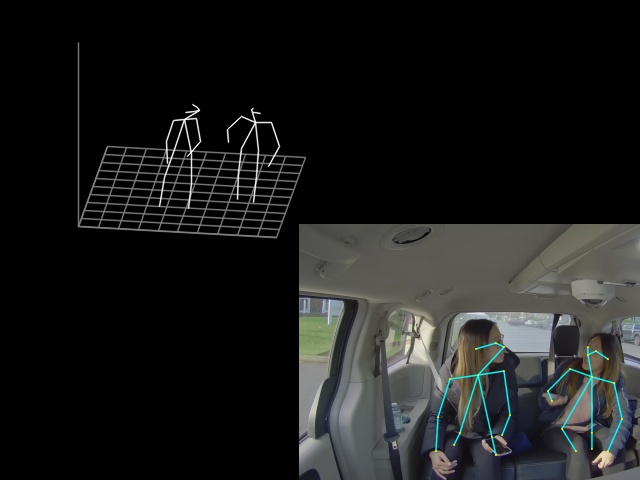- calculate gaze direction from 3D poses
- detect when people are looking at the camera
- determine which people are looking at each other (assumption is that they are probably at conversation, and the robot should not drive between them, but drive around)
Real-time 3D Multi-person Pose Estimation is based on https://github.com/Daniil-Osokin/lightweight-human-pose-estimation-3d-demo.pytorch/tree/master
This repository contains 3D multi-person pose estimation demo in PyTorch. Intel OpenVINO™ backend can be used for fast inference on CPU. This demo is based on Lightweight OpenPose and Single-Shot Multi-Person 3D Pose Estimation From Monocular RGB papers. It detects 2D coordinates of up to 18 types of keypoints: ears, eyes, nose, neck, shoulders, elbows, wrists, hips, knees, and ankles, as well as their 3D coordinates. It was trained on MS COCO and CMU Panoptic datasets and achieves 100 mm MPJPE (mean per joint position error) on CMU Panoptic subset. This repository significantly overlaps with https://github.com/opencv/open_model_zoo/, however contains just the necessary code for 3D human pose estimation demo.
The major part of the 3D-multi person pose estimation work was done by Mariia Ageeva
- Requirements
- Prerequisites
- Pre-trained model
- Running
- Inference with OpenVINO
- Inference with TensorRT
- Python 3.5 (or above)
- CMake 3.10 (or above)
- C++ Compiler (g++ or MSVC)
- OpenCV 4.0 (or above)
[Optional] Intel OpenVINO for fast inference on CPU. [Optional] NVIDIA TensorRT for fast inference on Jetson.
- Install virtual environment package:
sudo apt install python3-virtualenv
- Create virtual environment:
virtualenv -p python3 myvenv
- Activate virtual environment:
source myvenv/bin/activate
- Install requirements:
pip install -r requirements.txt
- Install OpenCV 4 for C++ (script clones opencv repo and builds):
bash opencv/install_cpp_opencv.sh
- Build
pose_extractormodule:
python setup.py build_ext
- Add build folder to
PYTHONPATH:
export PYTHONPATH=pose_extractor/build/:$PYTHONPATH
Pre-trained model is available at Google Drive.
Get it by running:
wget -O human-pose-estimation-3d.pth "https://drive.google.com/uc?export=download&id=1niBUbUecPhKt3GyeDNukobL4OQ3jqssH"
To run the demo, pass path to the pre-trained checkpoint and camera id (or path to video file):
python demo.py --model human-pose-estimation-3d.pth --video 0
For video files, use
python demo.py --model human-pose-estimation-3d.pth --video /path/to/video.mp4
Camera can capture scene under different view angles, so for correct scene visualization, please pass camera extrinsics and focal length with
--extrinsicsand--fxoptions correspondingly (extrinsics sample format can be found in data folder). In case no camera parameters provided, demo will use the default ones.
Inference with OpenVINO (not being able to make it run at the moment)
To run with OpenVINO, it is necessary to convert checkpoint to OpenVINO format:
- Install OpenVINO (in virtualenv)
pip install openvino-dev[pytorch,ONNX]==2022.3.0
- Set OpenVINO environment variables (only needed when built from source):
source <OpenVINO_INSTALL_DIR>/bin/setupvars.sh
- Convert checkpoint to ONNX:
python scripts/convert_to_onnx.py --checkpoint-path human-pose-estimation-3d.pth
- Convert to OpenVINO format:
python myvenv/lib/python3.10/site-packages/openvino/tools/mo/mo.py --input_model human-pose-estimation-3d.onnx --input=data --mean_values=data[128.0,128.0,128.0] --scale_values=data[255.0,255.0,255.0] --output=features,heatmaps,pafs
In case OpenVINO is built from source:
python <OpenVINO_INSTALL_DIR>/deployment_tools/model_optimizer/mo.py --input_model human-pose-estimation-3d.onnx --input=data --mean_values=data[128.0,128.0,128.0] --scale_values=data[255.0,255.0,255.0] --output=features,heatmaps,pafs
To run the demo with OpenVINO inference, pass --use-openvino option and specify device to infer on:
python demo.py --model human-pose-estimation-3d.xml --device CPU --use-openvino --video 0
Inference with TensorRT (not being able to make it run at the moment)
To run with TensorRT, it is necessary to install it properly. Please, follow the official guide, these steps work for me:
- Install CUDA 11.1.
- Install cuDNN 8 (runtime library, then developer).
- Install
nvidia-tensorrt:python -m pip install nvidia-pyindex pip install nvidia-tensorrt==7.2.1.6 - Install
torch2trt.
Convert checkpoint to TensorRT format:
python scripts/convert_to_trt.py --checkpoint-path human-pose-estimation-3d.pth
TensorRT does not support dynamic network input size reshape. Make sure you have set proper network input height, width with
--heightand--widthoptions during conversion (if not, there will be no detections). Default values work for a usual video with 16:9 aspect ratio (1280x720, 1920x1080). You can check the network input size withprint(scaled_img.shape)in the demo.py
To run the demo with TensorRT inference, pass --use-tensorrt option:
python demo.py --model human-pose-estimation-3d-trt.pth --use-tensorrt --video 0
Author of https://github.com/Daniil-Osokin/lightweight-human-pose-estimation-3d-demo.pytorch/tree/master has observed ~10x network inference speedup on RTX 2060 (in comparison with default PyTorch 1.6.0+cu101 inference).
